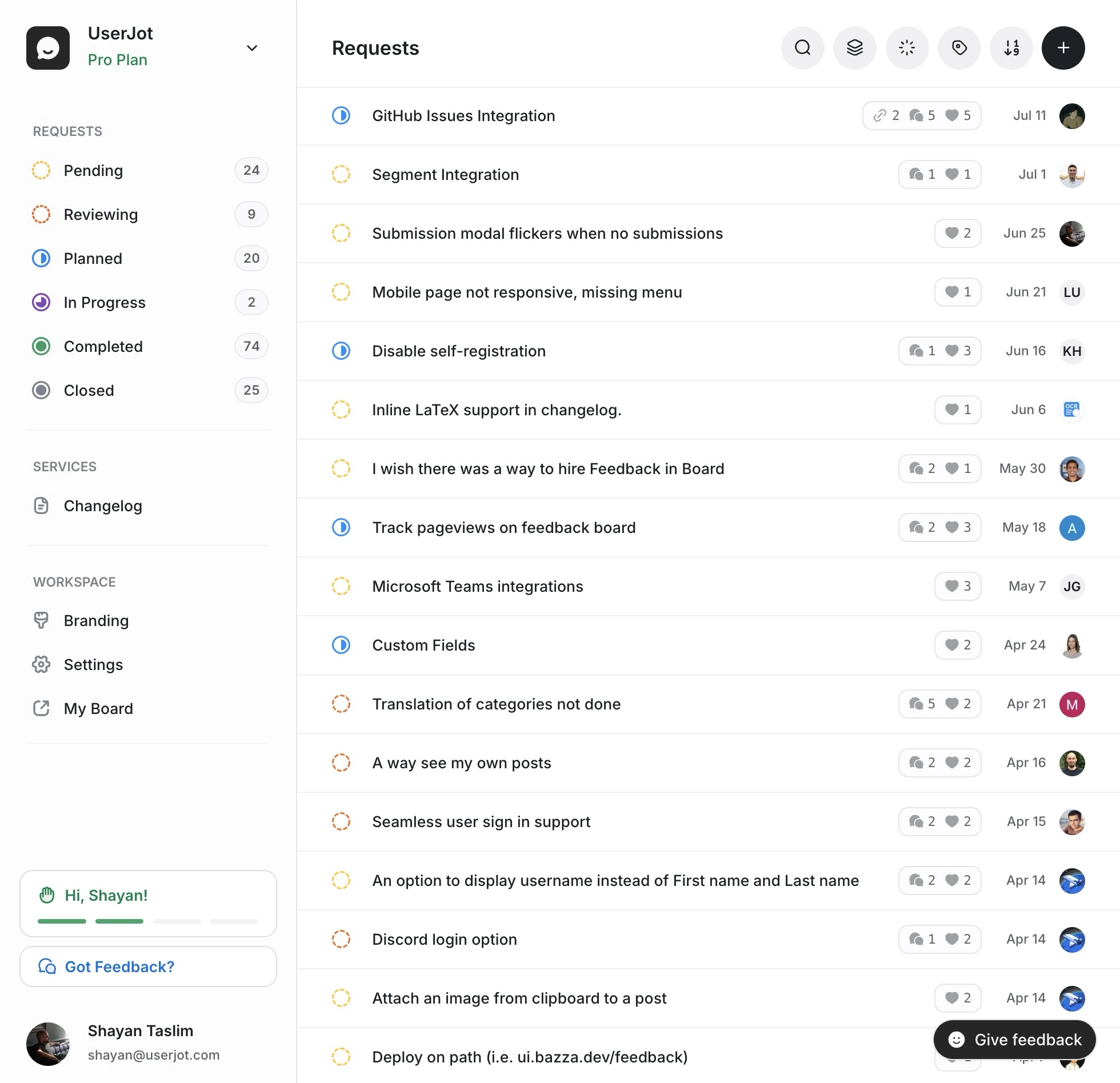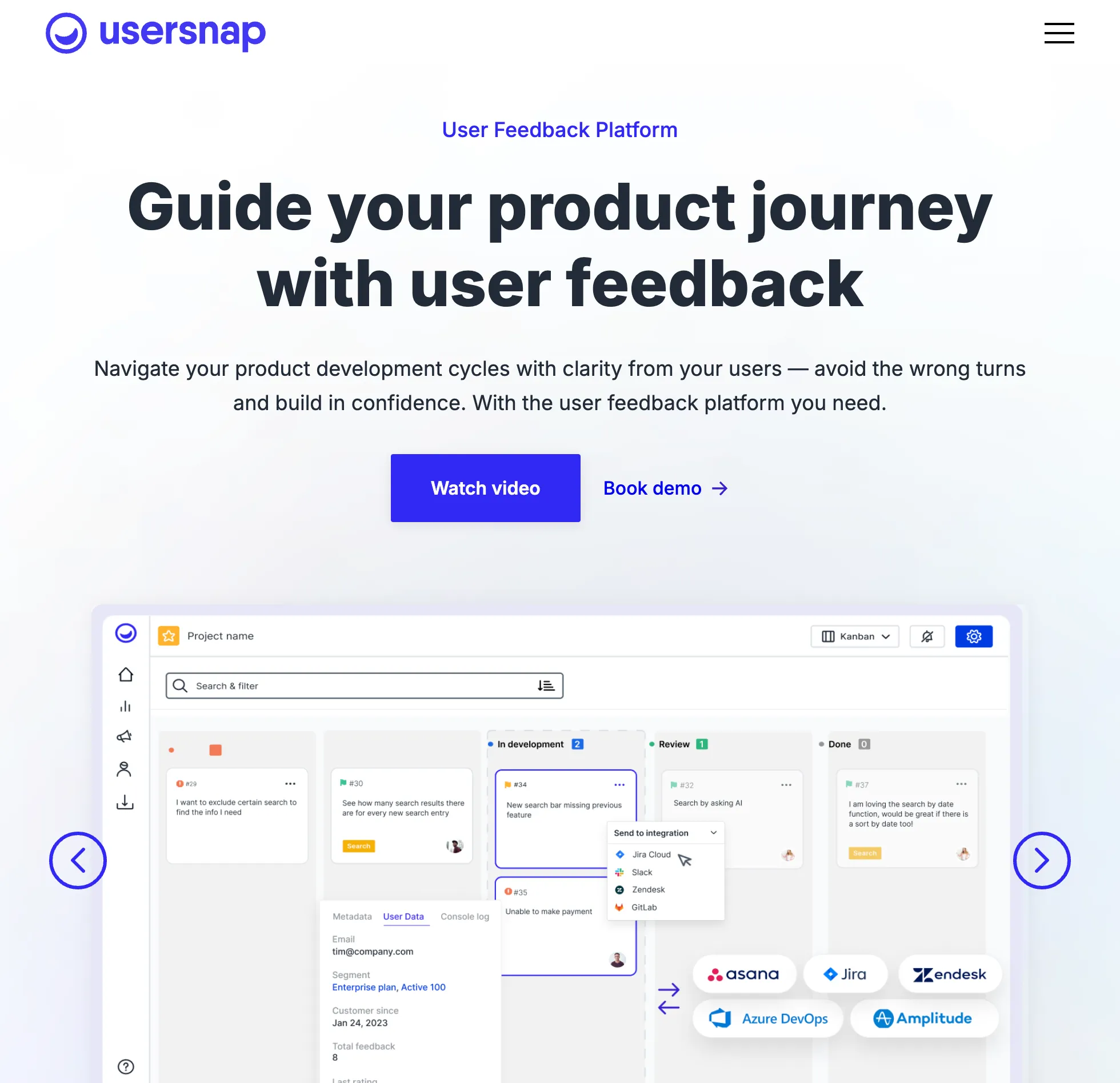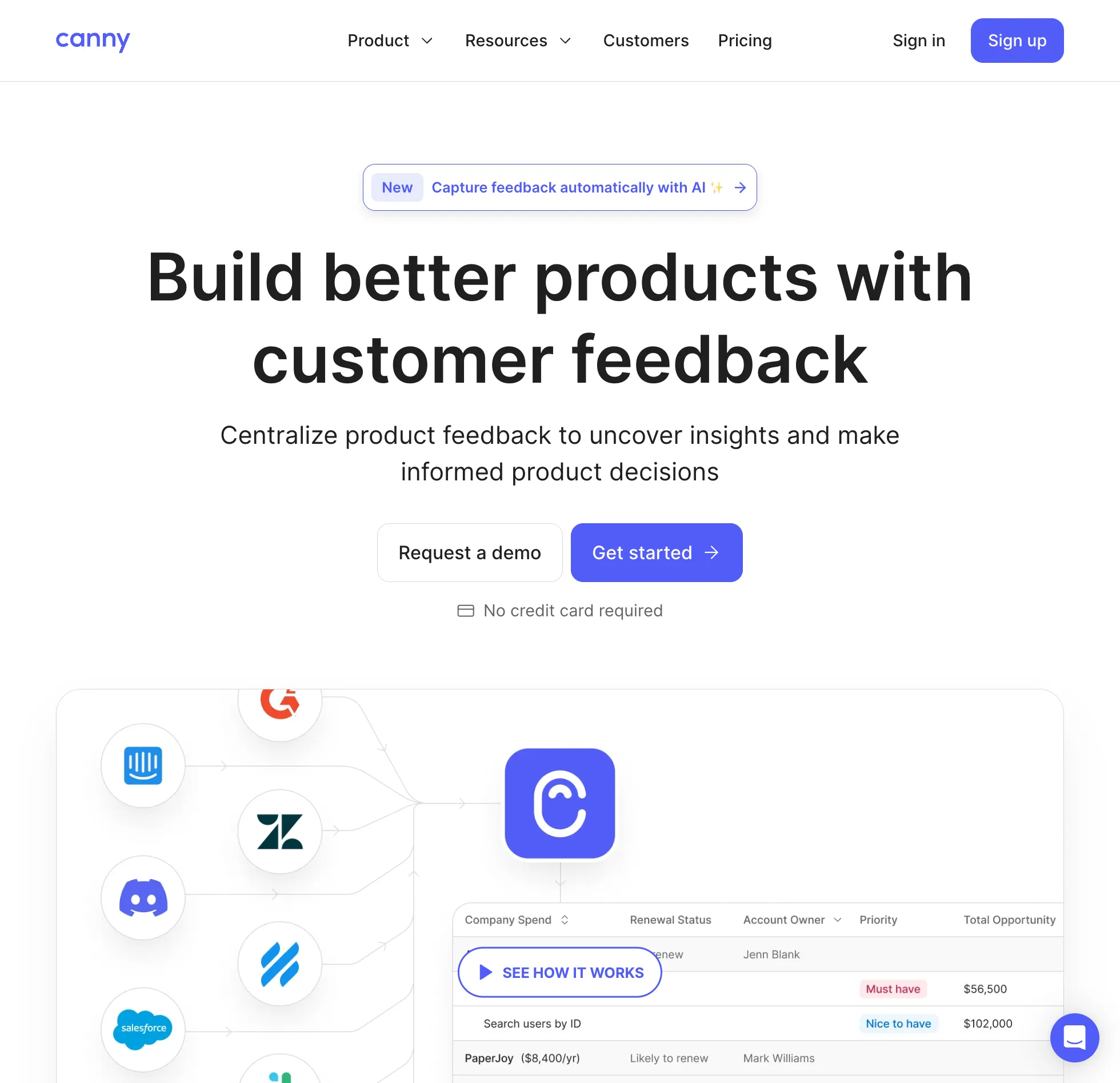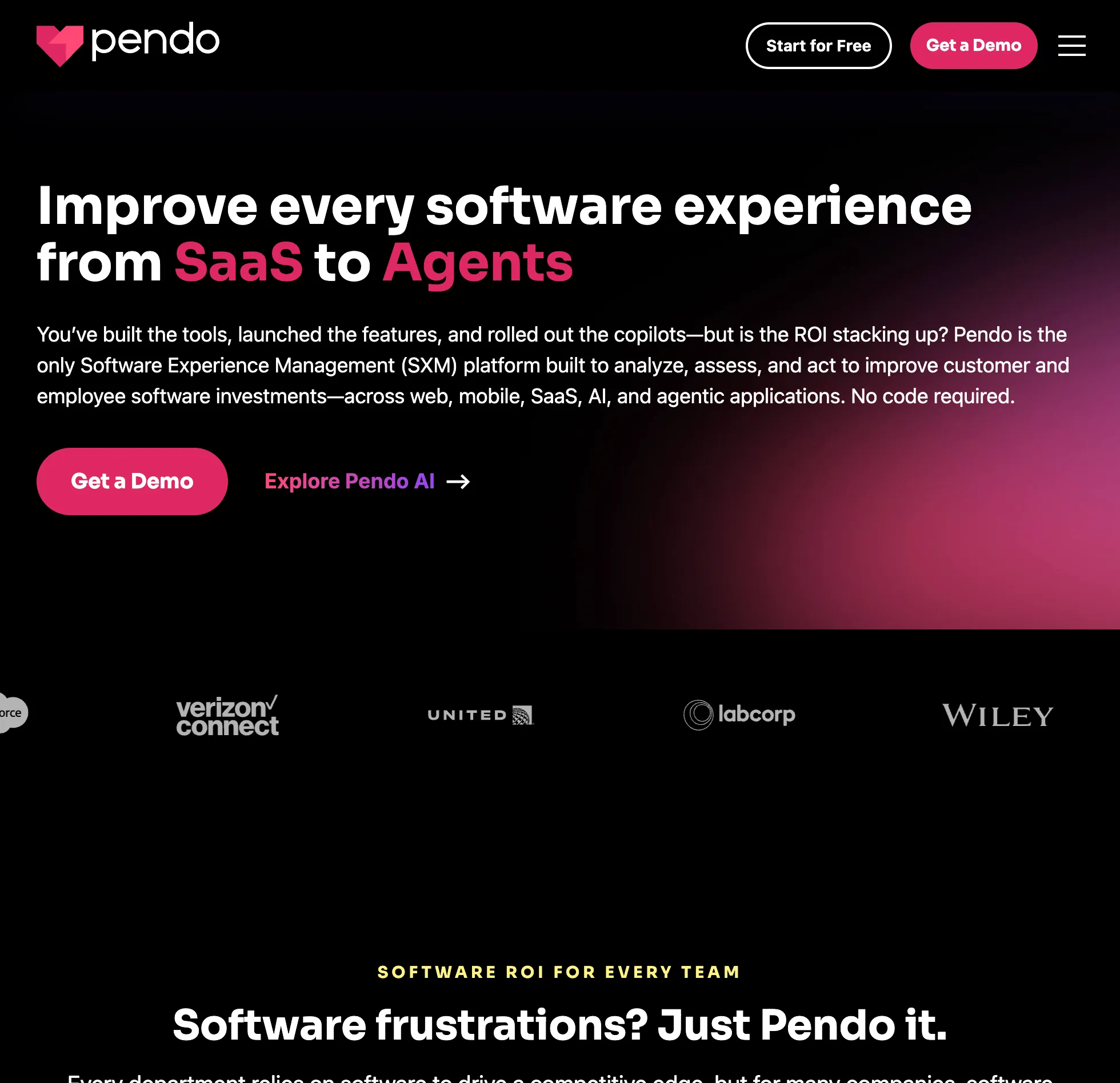Top 5 Userback Alternatives in 2026

Userback excels at visual bug tracking. Screenshots, annotations, session replays, console logs. It captures everything developers need to fix issues quickly. But at $7-23 per seat per month, with confusing pricing tiers and limited roadmap features, many teams find themselves paying for complexity they don’t need.
The real friction comes from client onboarding. Getting users to create accounts just to report bugs creates barriers that reduce participation. Plus, if you need actual product management features like public roadmaps, changelogs, or simple feature voting, Userback falls short. It’s a bug tracker trying to be a feedback tool, not the other way around.
What is Userback?
Userback is a visual feedback and bug tracking tool designed primarily for web development teams and digital agencies. Launched in 2016, it specializes in capturing visual context around bugs: screenshots with annotations, session recordings, console logs, and browser metadata. Users can highlight issues directly on web pages, making it easier for developers to understand and reproduce problems.
The platform integrates deeply with project management tools like Jira, Trello, and Asana, automatically creating tickets with all the visual context attached. This visual-first approach made Userback popular with QA teams and agencies managing client websites.
Why Teams Look for Userback Alternatives
While Userback handles visual bug tracking well, several limitations push teams to explore alternatives:
- Per-seat pricing pain: Costs scale quickly as your team grows ($7-23 per person)
- Client friction: Mandatory account creation reduces feedback participation
- Weak roadmap features: Basic kanban board, no public visibility
- No voting system: Can’t gauge user interest in fixes or features
- Limited to bugs: Not built for feature requests or general feedback
- Confusing pricing tiers: Different sources show different prices
- Missing changelog: No way to communicate updates to users
- Visual-only focus: Every feedback needs screenshots, even when text would work better
Here are 5 alternatives that take different approaches to collecting user feedback, from simple voting boards to comprehensive product management platforms.
Quick Comparison Table
| Tool | Starting Price | Pricing Model | Visual Tools | Roadmap/Changelog | Best For |
|---|---|---|---|---|---|
| UserJot | $29/month | Flat rate | Basic | Yes/Yes | Complete feedback |
| Usersnap | €39/month | Per seat | Advanced | Limited/No | Visual bugs |
| Canny | $79/month | Per user | No | Yes/Yes | Feature requests |
| Pendo | ~$2,000/month | Custom | Yes | Yes/Yes | Enterprise |
| Sleekplan | $13/month | Flat rate | No | Yes/Yes | Budget teams |
1. UserJot: Complete Feedback Without Complexity
UserJot flips the script on Userback’s approach. Instead of complex visual tools and technical data capture, we focus on making feedback collection effortless for both teams and users. No mandatory sign-ups, no seat-based pricing, no screenshot requirements.

Key Features
- Unlimited team members and users
- Guest feedback without accounts
- Public feedback boards with voting
- Public roadmaps with timeline views
- Automated changelog announcements
- AI-powered categorization and duplicate detection
- In-app widget for seamless collection
- Basic image attachments for bugs
- JWT-based SSO
- One-click migration tools
Pros
- No per-seat pricing: $29/month whether you have 5 or 50 team members
- Zero friction: Users submit feedback without creating accounts
- Complete product suite: Feedback, roadmaps, and changelogs included
- Modern interface: Clean design from 2025, not 2016
- Free forever plan: Start without payment
- Public by default: Built for transparency and engagement
Cons
- No session replay: Can’t watch user interactions
- Less technical data: No console logs or network capture
Pricing: Free forever with unlimited users and posts, $29/month Starter, $59/month Professional.
Best for: SaaS teams that need comprehensive feedback management beyond just bug tracking, without per-seat pricing complexity.
Stop guessing what to build. Let your users vote.
Try UserJot free2. Usersnap: The Direct Competitor
Usersnap is Userback’s most direct competitor, offering similar visual feedback features with a slightly different approach. Both started as screenshot tools and evolved into feedback platforms.

Key Features
- Advanced screenshot annotation
- Session replay with user actions
- Console log and network capture
- Browser and device metadata
- Voice and video feedback
- In-app feedback widgets
- Public feedback portals
- 50+ integrations
- Custom branding options
- Multi-language support
Pros
- Better feedback boards: Actual voting and public portals
- Modern interface: More polished than Userback
- Extensive widgets: More customization options
- Voice feedback: Audio recordings for context
- Strong integrations: Deep connections to PM tools
Cons
- Similar pricing model: Per-seat costs add up
- Expensive at scale: €249/month for 25 users
- Complex setup: Takes time to configure properly
- Overkill for simple needs: Too many features for basic feedback
Pricing: €39/month Startup (10 users), €99/month Company (15 users), €249/month Premium (25 users), custom Enterprise.
Best for: Teams that like Userback’s visual approach but want better feedback board features and a more polished interface.
3. Canny: Text-First Feedback
Canny represents a completely different philosophy than Userback. No screenshots, no session replays, no console logs. Just clean, simple feedback boards that users actually use.

Key Features
- Public voting boards
- Comment threads and discussions
- Automated status updates
- Public and private roadmaps
- Built-in changelog
- Jira and Linear sync
- Custom domains
- Moderation tools
- API access
- Analytics dashboard
Pros
- High engagement: Simple boards increase participation
- Public by default: Transparent product development
- Actual roadmaps: Real product planning tools
- Changelog included: Communicate updates effectively
- Modern design: Clean, minimal interface
- Fast setup: Running in 30 minutes
Cons
- No visual tools: Can’t annotate screenshots
- Not for bugs: Missing technical context capture
- User-based pricing: Costs scale with engagement
- Feature gating: Many features require higher tiers
Pricing: Free for 25 tracked users, $79/month Starter, $299/month Growth.
Best for: Product teams focused on feature development over bug tracking who value user engagement over technical depth.
4. Pendo: The Enterprise Solution
Pendo plays in a different league entirely. Where Userback focuses on visual feedback, Pendo combines product analytics, user guidance, and feedback into a comprehensive platform.

Key Features
- Complete product analytics
- User behavior tracking
- In-app guides and walkthroughs
- NPS and satisfaction surveys
- Feature adoption metrics
- User segmentation
- Session replay with analytics
- Roadmap planning tools
- Resource center creation
- Mobile app support
Pros
- Complete platform: Analytics, guidance, and feedback together
- Deep insights: Understand usage patterns and behavior
- Enterprise ready: SOC 2, GDPR, full compliance
- Powerful segmentation: Target specific user groups
- Strategic tools: Connect feedback to business metrics
Cons
- Extremely expensive: $20,000-50,000/year typical
- Complex implementation: Weeks or months to deploy
- Steep learning curve: Requires dedicated training
- Overkill for most: Too much for simple feedback needs
Pricing: Custom only, typically $20,000-50,000/year based on MAU.
Best for: Enterprise product teams needing comprehensive analytics and feedback in one platform, with budgets and resources to match.
5. Sleekplan: The Budget Balance
Sleekplan finds middle ground between Userback’s visual complexity and simpler feedback tools. It offers basic feedback collection without the overhead, plus features Userback lacks.

Key Features
- Feedback widget and boards
- Satisfaction tracking (CSAT, NPS)
- Public roadmaps
- Changelog system
- Guest feedback support
- Knowledge base (built-in)
- Custom CSS styling
- Email notifications
- User segmentation
- WordPress plugin
Pros
- Complete feature set: Feedback, roadmap, changelog, surveys
- Free plan available: Start without payment
- No per-seat costs: Flat monthly pricing
- All-in-one: Includes knowledge base too
- Very affordable: $13/month for paid plans
Cons
- Dated interface: UI feels old compared to modern tools
- Limited visual tools: No screenshots or annotations
- Basic functionality: Features work but aren’t sophisticated
- Slower performance: Can lag with lots of feedback
Pricing: Free plan available, $13/month Starter, $38/month Business.
Best for: Small teams wanting basic feedback collection with roadmap and changelog features, without visual complexity or high costs.
How to Choose the Right Userback Alternative
For visual bug tracking: Stay with Userback or try Usersnap. Both excel at screenshot annotation and session replay. Nothing else matches their visual depth.
For feature requests: UserJot ($29/month) or Canny ($79/month) drive better engagement with voting boards. Text-based feedback actually works better for feature ideas.
For complete product management: UserJot provides feedback, roadmaps, and changelogs at $29-59/month flat rate. Pendo offers enterprise scale at $20,000+/year.
For tight budgets: Sleekplan ($13/month) or UserJot’s free plan. Both eliminate per-seat costs that make Userback expensive for growing teams.
By team size: Solo developers and small teams (under 10) should use UserJot’s free plan or Sleekplan. Growing teams (10-50) benefit from UserJot’s flat pricing while Userback would cost $70-500/month. Enterprises (50+) should evaluate Pendo or negotiate custom deals.
Technical requirements: Only Userback, Usersnap, and Pendo offer session replay. Console logs are exclusive to Userback and Usersnap. For basic feedback without visual tools, UserJot, Canny, or Sleekplan work perfectly.
Migration difficulty: UserJot and Canny offer import tools (easy). Sleekplan supports CSV (moderate). Usersnap requires manual setup (hard). Pendo needs professional services (complex).
Making the Right Choice
If you need visual bug tracking: Stick with Userback or try Usersnap for a more modern interface with similar features.
If you want comprehensive feedback: UserJot provides feedback, roadmaps, and changelogs without per-seat pricing or complexity.
If you prefer text-based feedback: Canny offers clean boards that maximize user engagement without visual tools.
If you need enterprise features: Pendo combines analytics, guidance, and feedback for teams with big budgets.
If you want balance: Sleekplan provides basic everything at a fair price.
For most teams: UserJot hits the sweet spot. You get comprehensive feedback management without the visual complexity or per-seat pricing of Userback. Save the screenshot tools for actual bugs and use proper feedback tools for everything else.
The key insight: not every piece of feedback needs a screenshot. Feature requests, improvement ideas, and general suggestions often work better with simple text and voting. Choose tools that match your actual needs, not what vendors think you need.
Stop guessing what to build. Let your users vote.
Try UserJot freeFrequently Asked Questions
Why is Userback so focused on visual feedback?
Userback started as a screenshot annotation tool in 2016 for web agencies reporting bugs to clients. This visual-first heritage shapes everything: the features prioritize screenshots, the pricing assumes small teams, and the workflow centers on bug tracking. It excels at its original purpose but struggles to expand beyond visual bug reporting.
Can I migrate feedback from Userback to these alternatives?
UserJot offers migration assistance for feedback data. Canny and Sleekplan support CSV imports for basic data transfer. Moving visual bug reports is harder since screenshots and annotations don’t transfer well between platforms. Most teams migrate feature requests but keep historical bug data in Userback for reference.
Which alternative handles bug tracking best?
Usersnap is most similar to Userback for visual bug tracking, offering comparable screenshot annotation and session replay features. For text-based bug reporting, UserJot and Canny work fine without the visual overhead. The question isn’t which is “best” but whether you actually need visual annotation for your bug tracking workflow.
Do these alternatives offer session replay like Userback?
Only Usersnap and Pendo offer session replay among these alternatives. UserJot, Canny, and Sleekplan focus on feedback collection without behavioral tracking. Consider whether session replay is truly necessary - many teams find screenshots sufficient for bug reports and the added complexity isn’t worth it.
What’s the main advantage of UserJot over Userback?
No friction and predictable costs. UserJot eliminates barriers with guest feedback (no accounts required), flat-rate pricing (no per-seat costs), and simple interfaces (no training needed). Plus you get public roadmaps and changelogs included, transforming bug tracking into complete product management.
Is Userback’s pricing really that confusing?
Yes. Different pages show different prices, seat limits vary by plan, some features appear and disappear between tiers, and the distinction between “team members” and “collaborators” isn’t clear. Alternatives like UserJot use simple flat-rate pricing: $29 or $59/month, everything included, no calculations needed.
Which tool is best for client collaboration?
Depends on the client type. For technical clients reporting bugs, Userback or Usersnap provide the visual tools they might expect. For general users providing feedback, UserJot’s guest posting eliminates all friction. No accounts, no training, just a simple form. This typically increases participation by 2-3x.
Should I use different tools for bugs vs features?
Many successful teams do exactly this. GitHub Issues or Linear for technical bugs, UserJot or Canny for feature requests and user feedback. This separation makes sense: bugs need technical context and private discussion, features need public voting and community engagement. Using specialized tools for each purpose often works better than forcing one tool to handle everything.
How do these tools handle spam or low-quality feedback?
UserJot uses AI to detect duplicates and categorize feedback automatically. Canny offers moderation queues and manual approval. Userback focuses on authenticated users which reduces spam but also reduces participation. Sleekplan provides basic moderation. The trade-off is always between openness (more feedback) and quality (less noise).
What about mobile app feedback?
Most of these tools focus on web applications. Userback and Usersnap handle mobile web but not native apps well. Pendo offers dedicated mobile SDKs but at enterprise prices. For native mobile apps, consider specialized tools like Instabug or Shake, or use UserJot’s API to build custom mobile feedback flows.